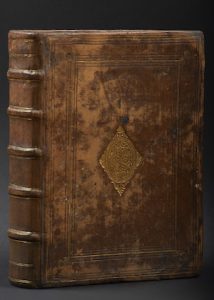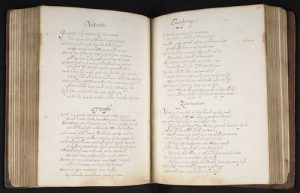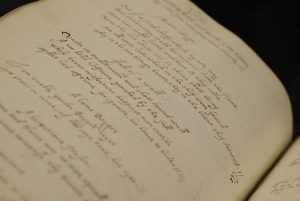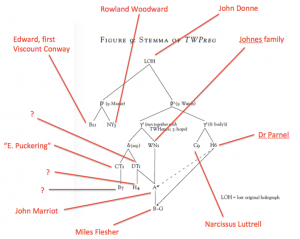It’s been called one of the greatest literary discoveries of a generation: a hugely significant and previously unknown manuscript of John Donne’s poetry which was lost for years and found in a Suffolk country house in 2018 by Sotheby’s expert Gabriel Heaton. After disappearing from public view during all the confusion of 2020, the ‘Melford manuscript’ has now officially found a home at the British Library.

When the manuscript sold at auction it was expected to raise £200,000–£300,000: in fact, it sold for a breath-taking £475,000 (or rather £387,500, plus auctioneer’s commission). The drama of its discovery only increased when the original sale was blocked after an appeal to the UK government, on the grounds that this discovery was such a valuable part of the UK’s cultural history. The British Library was given a chance to raise the equivalent money, and the announcement was finally made on Monday 7 December 2020, along with the publication of a high-quality digitization, of the newly named ‘Egerton MS 3884’.
Even to those of us who love these things, half a million pounds is clearly an enormous amount of money to pay for a single text. How exactly might we start thinking about the cultural value of an object like this?
Answering this question takes us deep into the heart of the textual cultures of the English Renaissance (c.1500–1700), precisely the kind of thing the early modernists in King’s English Department love to investigate (check out the Instagram page for our MA in ‘Text and Transmission’ to find out more about studying these kinds of issues at graduate level).

I want to ask a couple of connected questions in response to this discovery and high-profile auction sale: why this manuscript is considered so important; and how we can use artifacts like this to find out more about early modern literary culture.
But let’s go back to the beginning: what is the Melford Hall Manuscript, and what’s so impressive about it? Melford, as I’ll call it from now on, is a large, expensively bound manuscript volume containing previously unknown witnesses of nearly 140 poems by John Donne (1572–1631), one of the most outstandingly significant poets and preachers of the early modern period. You’ll probably know Donne as the author of the racy Songs and Sonnets, or the masochistically passionate Holy Sonnets, as the long-fingered Ben Whishaw lookalike of the famous Lothian portrait, or the source of the resonant line ‘No man is an island’ (recently spotted as a Brexit Remainer catchphrase).
Melford contains examples across all the kinds of poetry he wrote, from the very famous, including the elegy ‘To his mistress going to bed’, to lesser-studied pieces such as the epigrams. (The page chosen to illustrate the Guardian’s article on this story highlighted the four-line epigram ‘Fall of a wall’, bringing fame at last to this virtually unknown verse!) The manuscript is professionally inscribed in a beautiful clear hand, and is preserved in an expensive binding.

Donne was born in London into a highly Catholic family; he studied at Oxford and The Inns of Court, where he composed much of his poetry. His early secular success as secretary to the Lord Keeper of the Privy Seal (a senior government administrator) was thrown dramatically off course by a socially disastrous clandestine marriage to Anne More, his employer’s niece. After years on the margins of society carefully considering his religious beliefs, he was ordained a Church of England clergyman in 1615, and ended his life as Dean of St Paul’s Cathedral.
Donne’s daring and groundbreaking poetry was printed posthumously as Poems, by J. D. in 1633 (then again in 1635 and five other seventeenth-century printings), but many of its earliest readers would have encountered him in handwritten scribal copies. Donne was the most transcribed literary author of his day by a factor of five: he was a true publishing phenomenon of the manuscript medium. You might think of a cross between Bob Dylan bootlegs copied from tape to tape by hungry fans in the ’60s and a social media post going viral today.
This is why Melford is quite so important: it’s the second-largest known collection of Donne’s verse in manuscript, and forces scholars to reconsider everything they know about the early transmission of his writing. I’ve spent much of my research career so far trying to understand how his verse circulated – who took the time to copy it, who commissioned scribes, who thought it valuable enough to seek out and collect. Doing so helps us understand how and why this author – who vigorously restricted the readership of his writing in his own day – became such an important cultural icon in the centuries following his death.
It’s a particularly exciting time to be working on Donne’s manuscripts. Melford follows hard on the heels of another exciting discovery in 2016, in Westminster Abbey, by Matthew Payne. For a full study of that discovery, see here, and for follow-up analysis on the King’s English blog, see here. (To find out more about another department member’s research into scribal activity check out Lawrence Warner’s recent work on Chaucer’s scribes, which has proved both pioneering and controversial.)
How we can use manuscripts like this?
First things first: we hardly have any of Donne’s poetry in his own hand. A famous exception is a verse letter now held in the Bodleian Library in Oxford. Almost everything else – and there’s a lot of it, some 4000 individual witnesses to poems – survives in scribal copies (this count doesn’t include the poems in Melford). Some of those scribes were Donne’s friends and acquaintances; others that we can identify were not; many more remain anonymous.
By comparing these texts at an extremely close textual level, we can create ‘stemmata’ – textual family trees that convey something of the ‘DNA’ of a text. Each time a poem is copied, a mistake is almost always introduced. Textual criticism aims to reconstruct authorial originals by comparing all those corruptions.
Here’s an example of a textual stemma, taken from the standard-setting Donne Variorum project, of Donne’s verse letter to his friend Thomas Woodward beginning ‘Pregnant again with the old twins, hope and fear’ (the poem’s ‘siglum’, or codename, here is TWPreg). It traces the descent of the text from Donne’s original manuscript (LOH, or Lost Original Holograph) to printed editions (coded as A–G). All the codes in between are manuscripts; I’ve marked up the Variorum’s stemma to show that we can put real people’s names to certain copies, either as scribes or owners.

Melford gives us a rich source of new data to expand our stemmata. Gabriel Heaton at Sotheby’s has argued persuasively that Melford is related to DT1 in the chart above (Trinity College, Dublin MS 877) – what that means is that both texts were copied from the same source, so share common textual ‘DNA’. More work on the text will show the precise relationship between the two, and allow scholars to think about the kinds of networks circulating Donne’s poetry at this time.
What this artifact tells us about early modern literary culture
Why bother doing all this fiddly textual and archival work? Well, the more scribes and patrons we can identify, the richer our picture becomes of the kind of work a poem did in early modern England. After all, when was the last time you copied out a poem and gave it to someone? Why would someone do such a thing?
In a Latin poem (here quoted in an English translation by Edward Blunden), Donne himself seems to have put his finger on the magic of an original manuscript:
What Printing-presses yield we think good store,
But what is writ by hand we reverence more:
A Book that with this printing-blood is dyed
On shelves for dust and moth is set aside,
But if’t be penned it wins a sacred grace
And with the ancient Fathers takes its place.(De Libro Cum Mutuaretur [Poem to Dr Andrews])
A manuscript was considered to have something of the author’s or scribe’s ‘presence’, and resists the reproductive logic of the mass-market printing press. But if we are tempted to ‘reverence’ such refined, elite activity, we should remember that some of Donne’s contemporary poets rolled their eyes at the pretention of it all.
When we encounter Donne’s poetry in manuscript, we’re also witnessing an ideological battle between proponents of different media (print and manuscript): Thomas Campion (1567–1620) was scathing of those who ‘taste nothing that comes forth in print, as if Catullus or Martials Epigrammes were the worse for being published.’ Michael Drayton (1563–1631) complained about living at a ‘time, when Verses are wholly deduc’t to Chambers, and nothing esteem’d in this lunatique Age, but what is kept in Cabinets, and must only pass by transcription.’ Drayton laments the fetishization of the handwritten, its pretentions to exclusive, coterie circulation.

© National Portrait Gallery, London
Similarly, Richard Niccols (c.1583–1616) mocked ‘many idle humorists whose singularity allowes nothing good, that is common’ and in whose ‘fine fingers no papers are [w]holesome, but such, as passe by private manuscription.’ For ‘wholesome’, we might perhaps read ‘cool’: nothing says hipster like an exclusive-access network (think back to those Dylan bootlegs!).
Viewed in these terms, whether or not his contemporaries liked it, no author in the period had anything like the cachet of Donne. The Melford manuscript gives us rich new opportunities for studying not just this poet, but the fascinating cultures of early modern textual transmission.
Interested in finding out more the textual cultures of early modern English literature, and doing hands-on work with rare books and manuscripts like this one? Check out King’s MA in Early Modern English Literature: Text and Transmission, or email daniel.s.smith@kcl.ac.uk.
Blog posts on King’s English represent the views of the individual authors and neither those of the English Department, nor of King’s College London.
You may also like to read:

